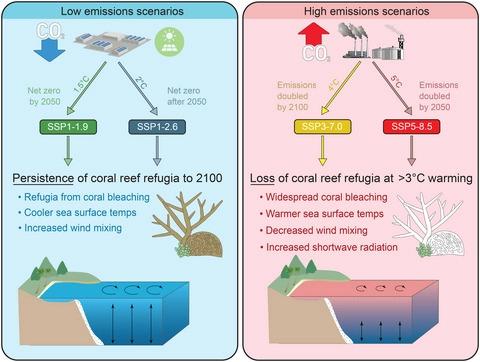当前位置:
X-MOL 学术
›
Glob. Change Biol.
›
论文详情
Our official English website, www.x-mol.net, welcomes your
feedback! (Note: you will need to create a separate account there.)
Climate refugia on the Great Barrier Reef fail when global warming exceeds 3°C
Global Change Biology ( IF 10.8 ) Pub Date : 2022-08-02 , DOI: 10.1111/gcb.16323 Jennifer K McWhorter 1, 2, 3 , Paul R Halloran 1 , George Roff 2, 4 , William J Skirving 5, 6 , Peter J Mumby 2
Global Change Biology ( IF 10.8 ) Pub Date : 2022-08-02 , DOI: 10.1111/gcb.16323 Jennifer K McWhorter 1, 2, 3 , Paul R Halloran 1 , George Roff 2, 4 , William J Skirving 5, 6 , Peter J Mumby 2
Affiliation

|
Increases in the magnitude, frequency, and duration of warm seawater temperatures are causing mass coral mortality events across the globe. Although, even during the most extensive bleaching events, some reefs escape exposure to severe stress, constituting potential refugia. Here, we identify present-day climate refugia on the Great Barrier Reef (GBR) and project their persistence into the future. To do this, we apply semi-dynamic downscaling to an ensemble of climate projections released for the IPCC's recent sixth Assessment Report. We find that GBR locations experiencing the least thermal stress over the past 20 years have done so because of their oceanographic circumstance, which implies that longer-term persistence of climate refugia is feasible. Specifically, tidal and wind mixing of warm water away from the sea surface appears to provide relief from warming. However, on average this relative advantage only persists until global warming exceeds ~3°C.
中文翻译:

当全球变暖超过 3°C 时,大堡礁的气候保护区就会失败
温暖海水温度的幅度、频率和持续时间的增加正在导致全球范围内的大规模珊瑚死亡事件。尽管如此,即使在最广泛的白化事件期间,一些珊瑚礁也逃脱了严重的压力,构成了潜在的避难所。在这里,我们确定了大堡礁(GBR)目前的气候保护区,并预测它们在未来的持续存在。为此,我们对 IPCC 最近的第六次评估报告发布的气候预测集合应用了半动态降尺度。我们发现,大堡礁地区在过去 20 年中经历的热应力最小是由于其海洋环境,这意味着气候保护区的长期持续存在是可行的。具体来说,远离海面的温水的潮汐和风混合似乎可以缓解变暖现象。然而,平均而言,这种相对优势仅持续到全球变暖超过约 3°C。
更新日期:2022-08-02
中文翻译:

当全球变暖超过 3°C 时,大堡礁的气候保护区就会失败
温暖海水温度的幅度、频率和持续时间的增加正在导致全球范围内的大规模珊瑚死亡事件。尽管如此,即使在最广泛的白化事件期间,一些珊瑚礁也逃脱了严重的压力,构成了潜在的避难所。在这里,我们确定了大堡礁(GBR)目前的气候保护区,并预测它们在未来的持续存在。为此,我们对 IPCC 最近的第六次评估报告发布的气候预测集合应用了半动态降尺度。我们发现,大堡礁地区在过去 20 年中经历的热应力最小是由于其海洋环境,这意味着气候保护区的长期持续存在是可行的。具体来说,远离海面的温水的潮汐和风混合似乎可以缓解变暖现象。然而,平均而言,这种相对优势仅持续到全球变暖超过约 3°C。











































 京公网安备 11010802027423号
京公网安备 11010802027423号